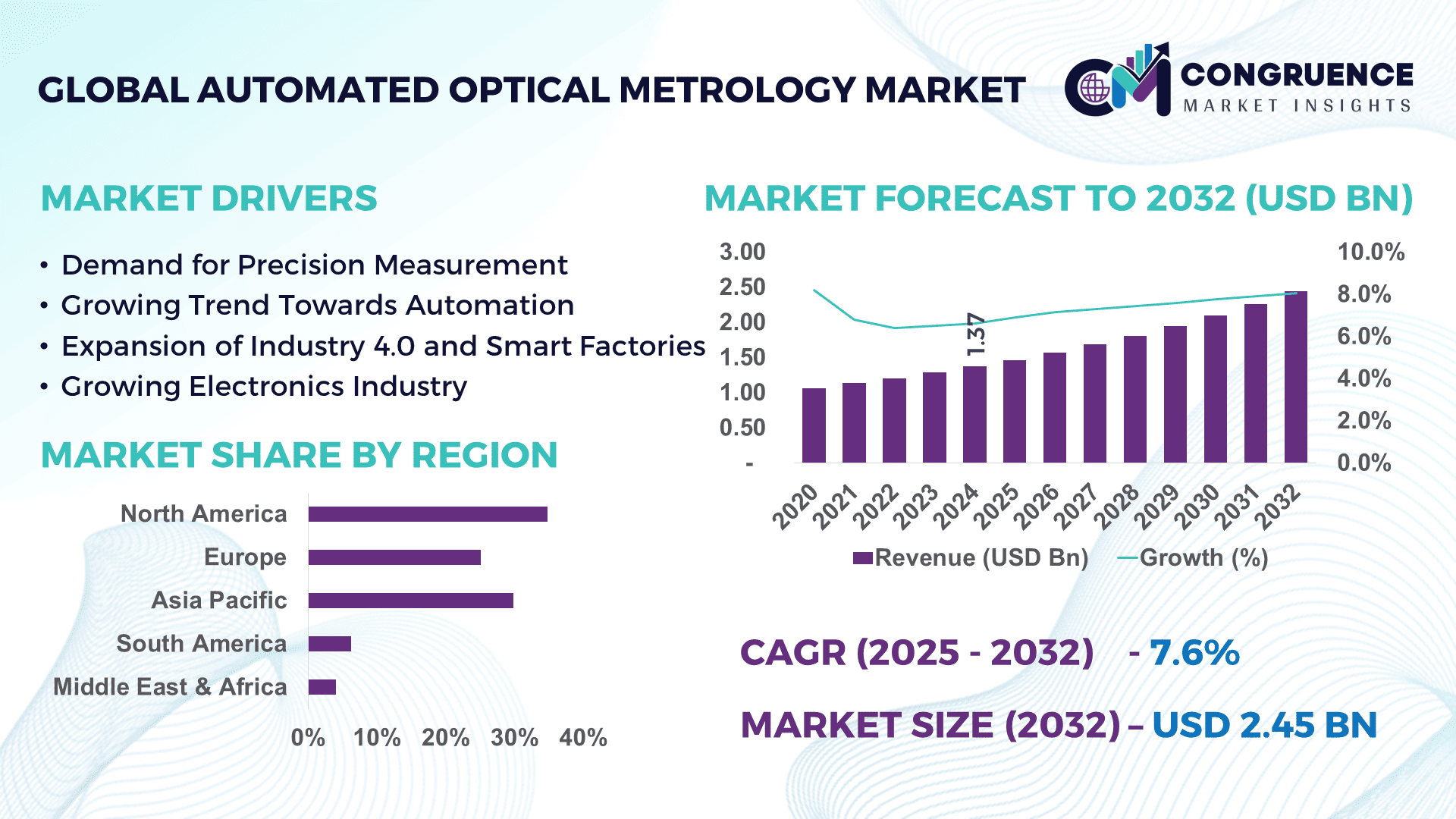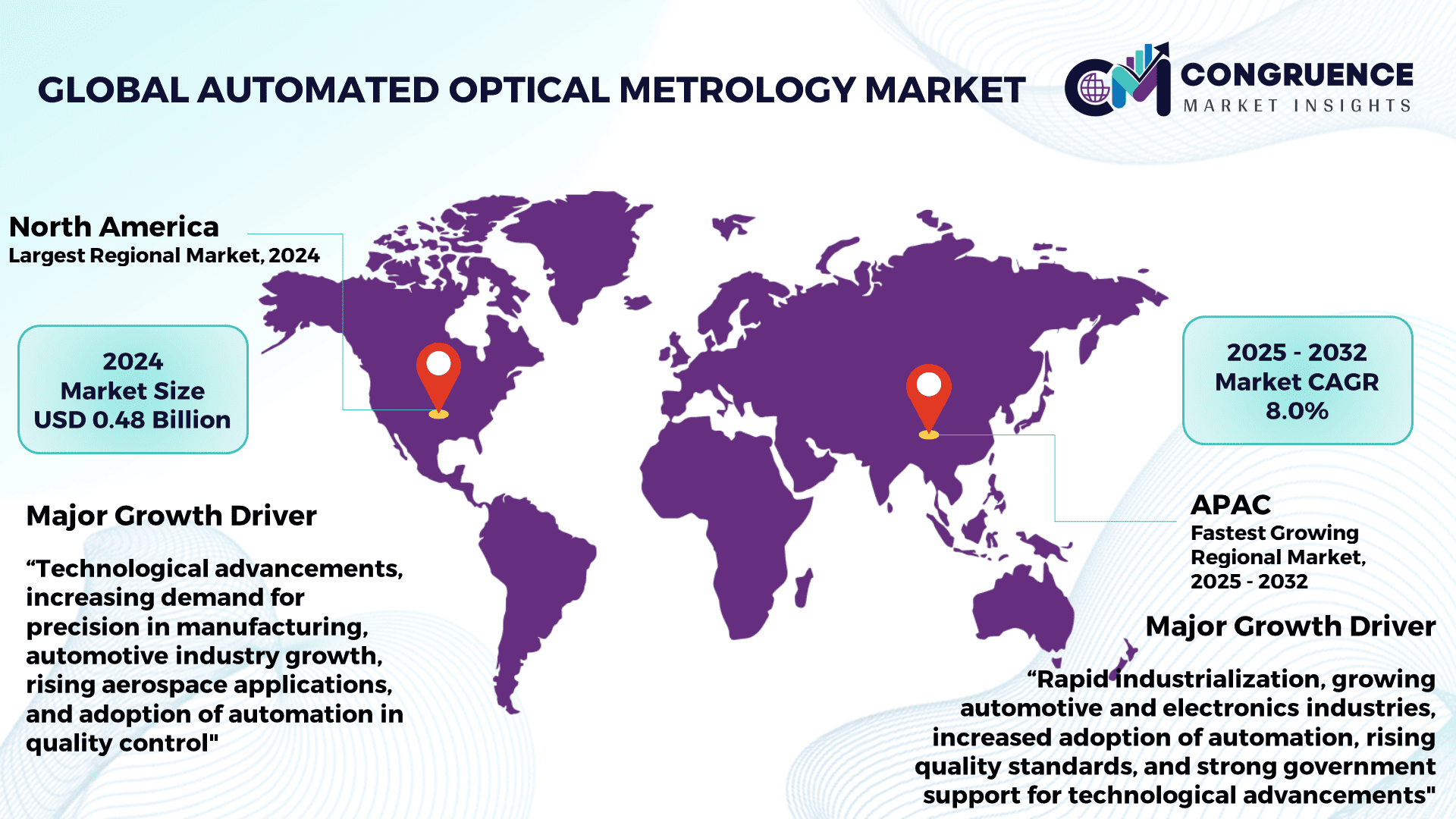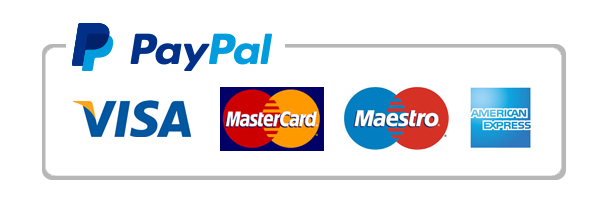Reports
Automated Optical Metrology Market Report Overview
The Global Automated Optical Metrology Market was valued at USD 1.37 Billion in 2024 and is anticipated to reach a value of USD 2.45 Billion by 2032 expanding at a CAGR of 7.6% between 2025 and 2032. The global automated optical metrology market is being pushed by advances in manufacturing technologies, increased usage of precision-based inspection systems, and the rapid evolution of industries such as automotive and aerospace.

To Learn More About This Report, Request A Free Sample Copy
Automated optical metrology systems are becoming increasingly popular due to their ability to offer precise, non-contact measurements for a wide range of industrial applications. These systems use advanced optical technologies such as laser scanners, vision systems, and 3D digitizers to measure complex geometries with great precision and accuracy. The automotive, aerospace, and electronics industries rely significantly on optical metrology to assure quality control, process optimization, and efficient production workflows. Moreover, the demand for greater measurement accuracy, the advent of smart factories, and the incorporation of automation into inspection processes are all key drivers of market expansion. The market is expanding rapidly as organizations adopt automation to improve efficiency, accuracy, and production across several industries. Automated optical metrology has several advantages over traditional approaches, including reduced human error, faster inspection times, and real-time monitoring of complicated operations. As industries evolve, the demand for automated optical metrology equipment is likely to increase tremendously.
How AI is Transforming Automated Optical Metrology Market
Artificial intelligence (AI) is transforming the automated optical metrology market by offering new capabilities that improve measuring systems' precision, efficiency, and adaptability. AI-powered systems analyze massive volumes of data to detect flaws, streamline manufacturing processes, and assure consistent quality control. AI's capacity to recognize anomalies and make real-time modifications dramatically saves downtime and operational expenses in manufacturing settings.
By learning from past data, artificial intelligence improves pattern identification, accelerates image processing, and increases measurement accuracy in automated optical metrology. It provides predictive maintenance by monitoring equipment performance and detecting potential defects before they happen. AI algorithms may optimize metrology procedures, assuring optimal resource allocation while minimizing user intervention.
Furthermore, AI-powered automation improves the performance of 3D scanning and coordinate measuring machines (CMM), making them smarter, faster, and more dependable. With AI's increasing integration, automated optical metrology systems are becoming more versatile, providing exceptional flexibility to meet changing manufacturing needs. As AI technology advances, its impact on the automated optical metrology business will become more substantial.
Automated Optical Metrology Market Major Driving Forces
· Demand for Precise Measurements: The growing demand for precision measurement in the automotive, aerospace, and healthcare industries drives the automated optical metrology market.
· Rising Automation: The increasing trend of automation in manufacturing processes stimulates the use of automated metrology systems to improve efficiency and reduce errors.
· Smart Factories: The growth of Industry 4.0 and smart factories is driving up demand for automated optical metrology systems, particularly those for real-time quality monitoring.
· Growing Electronics Industry: The increase in consumer electronics and semiconductor manufacturing necessitates high-precision optical metrology for defect identification and process optimization.
Automated Optical Metrology Market Key Opportunities
· Integrating with AI: The use of AI and machine learning into optical metrology provides significant prospects for optimizing measurement methods and increasing operational efficiency.
· Growth in 3D Scanning: The growing need for 3D scanning technology in industries such as automotive, aerospace, and healthcare creates new opportunities for market expansion.
· Rising Demand for Automated Inspection: The growing trend of automation in quality inspection and defect identification creates considerable opportunity for manufacturers to implement optical metrology systems.
· Adoption of Smart Manufacturing: As smart manufacturing methods and digital twins become more prevalent in production environments, the automated optical metrology industry has chances to expand.
Automated Optical Metrology Market Key Trends
· The use of 3D optical metrology solutions in the automotive and aerospace sectors is a major trend in the automated optical metrology market.
· The use of non-contact inspection methods in production environments to achieve precise measurements without destroying parts is gaining popularity.
· Hybrid metrology systems, which integrate optical, laser, and traditional measuring technologies to improve precision, are becoming increasingly common.
· Companies are focused on energy-efficient and ecologically sustainable metrology systems to line with the global push for eco-friendly manufacturing processes.
Region-wise Market Insights
North America accounted for the largest market share at 34.8% in 2024 however, Asia Pacific is expected to register the fastest growth, expanding at a CAGR of 8.0% between 2025 and 2032.

To Learn More About This Report, Request A Free Sample Copy
North America was the largest region in the automated optical metrology market in 2024. The existence of well-established manufacturing businesses, combined with high adoption rates of advanced technologies, propels the market in this area. The United States dominates the North American market thanks to its strength in automobile, aircraft, and semiconductor manufacturing.
· In February 2025, Topcon and FARO Technologies announced a strategic partnership to advance laser scanning technology. This collaboration aims to combine their expertise in 3D measurement and geospatial solutions to offer innovative and precise laser scanning products for industries such as construction, surveying, and manufacturing. The agreement is set to enhance productivity and accuracy in capturing high-quality data for various applications.
Asia Pacific is predicted to have the fastest growth rate, with a CAGR of 8.0% between 2025 and 2032. China, Japan, and South Korea are setting the pace with huge investments in manufacturing automation and smart factories. The region's expanding electronics and automotive sectors additionally help to drive the growth of the automated optical metrology market.
High-precision metrology systems are being adopted in industries such as aerospace, automotive, and defense, which is driving the market in Europe. Countries such as Germany and France are important players, with advanced manufacturing skills. The Middle East, Africa, and Latin America are expanding markets with growing investments in manufacturing infrastructure and industrial automation.
Recent Developments
· In March 2025, ZEISS hosted a major event showcasing the future of metrology, highlighting cutting-edge technological advancements and innovative solutions aimed at transforming precision measurement across industries. The event featured new tools and technologies designed to enhance accuracy, efficiency, and automation in industrial metrology, reinforcing ZEISS's leadership in the field. Attendees had the opportunity to explore these innovations through live demonstrations and presentations.
· In October 2024, Mitutoyo America Corporation released the new Metlogix M3 software integrated with the Mitutoyo Quick Image Vision System. This system enhances measurement efficiency with advanced image processing capabilities, providing users with a streamlined interface for precise inspections. The combination aims to improve accuracy and speed in industrial metrology, making it a valuable tool for various industries that require high-quality measurement solutions.
· In April 2024, Creaform introduced its latest generation of optical CMM 3D scanners, aimed at enhancing the user experience for quality control professionals. These advanced scanners offer greater accuracy, speed, and ease of use, making them ideal for industries like manufacturing and engineering. The new features significantly improve precision in measurement and inspection processes, enabling better quality control and efficiency in production environments.
· In March 2023, Keyence launched a multisensor measurement system designed for high-precision, automated dimensional inspections. This system integrates optical, contact, and laser-based measurement technologies, enabling accurate and efficient inspections across a range of materials and surfaces. The advanced system is tailored to meet industry demands for faster, more reliable, and highly adaptable measurement solutions, making it a significant innovation in metrology for industries like manufacturing, automotive, and aerospace.
Market Competition Landscape
The global automated optical metrology market is highly competitive, with several leading companies focusing on technical innovation, mergers, and strategic alliances to preserve a competitive advantage. Leading organizations are investing more in AI, 3D scanning, and high-speed measurement technology to differentiate their goods. Market leaders such as Carl Zeiss AG, and Nikon Metrology are constantly extending their product offerings to meet the growing demand for advanced metrology equipment. Companies are also looking into agreements with AI companies to improve the capabilities of their automated systems. Furthermore, regional companies in Asia Pacific and Europe are increasing market share by providing specialized services including hybrid metrology solutions and AI-integrated systems.
Key players in the global automated optical metrology market implement various organic and inorganic strategies to strengthen and improve their market positioning. Prominent players in the market include:
· Carl Zeiss AG
· Nikon Metrology
· Keyence Corporation
· Mitutoyo Corporation
· FARO Technologies, Inc.
· GOM GmbH
· KLA Corporation
· Perceptron, Inc.
· Renishaw PLC
· Creaform
· Bruker Corporation
· Jenoptik AG
· CyberOptics Corporation
|
Report Attribute/Metric |
Details |
|
Market Revenue in 2024 |
USD 1.37 Billion |
|
Market Revenue in 2032 |
USD 2.45 Billion |
|
CAGR (2025 – 2032) |
7.6% |
|
Base Year |
2024 |
|
Forecast Period |
2025 – 2032 |
|
Historical Data |
2020 to 2024 |
|
Forecast Unit |
Value (US$ Bn) |
|
Key Report Deliverable |
Revenue Forecast, Growth Trends, Market Dynamics, Segmental Overview, Regional and Country-wise Analysis, Competition Landscape |
|
Segments Covered |
· By Type (3D Laser Scanners, Coordinate Measuring Machines, Video Measuring Machines, Optical Comparators) · By Frequency (Low Frequency, High Frequency) · By End-Use Industry (Automotive, Aerospace & Defense, Electronics, Healthcare, Manufacturing and Others) · By Application (Surface Inspection, Dimensional Measurement, Defect Detection, 3D Scanning, Reverse Engineering) |
|
Geographies Covered |
North America: U.S., Canada and Mexico Europe: Germany, France, U.K., Italy, Spain, and Rest of Europe Asia Pacific: China, India, Japan, South Korea, Southeast Asia, and Rest of Asia Pacific South America: Brazil, Argentina, and Rest of Latin America Middle East & Africa: GCC Countries, South Africa, and Rest of Middle East & Africa |
|
Key Players Analyzed |
Carl Zeiss AG, Nikon Metrology, Keyence Corporation, Mitutoyo Corporation, FARO Technologies, Inc., GOM GmbH, KLA Corporation, Perceptron, Inc., Renishaw PLC, Creaform, Bruker Corporation, Jenoptik AG, CyberOptics Corporation |
|
Customization & Pricing |
Available on Request (10% Customization is Free) |
